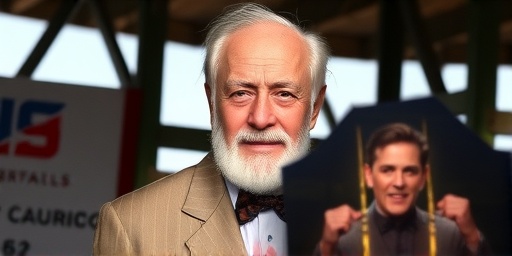In a shocking loss to the entertainment world, veteran stuntman Carl Ciarfalio has passed away at the age of 72, his death announced by close family members on social media. Known for his gravity-defying performances in some of Hollywood’s most explosive action sequences, Ciarfalio’s sudden departure leaves a void in the film industry, where he spent over four decades pushing the boundaries of physical storytelling on screen.
- Ciarfalio’s High-Octane Debut: Breaking into Hollywood’s Daredevil Scene
- Daredevil Mastery in Superhero Sagas: Ciarfalio’s Blockbuster Stunts That Stole the Show
- Unsung Hero of the Crew: Ciarfalio’s Mentorship and Safety Advocacy in the Stunt Community
- Tributes Flood In: Hollywood Stars and Fans Mourn Ciarfalio’s Enduring Legacy
- Shaping Tomorrow’s Action: Ciarfalio’s Influence on Future Stunt Innovations and Tributes
Ciarfalio’s High-Octane Debut: Breaking into Hollywood’s Daredevil Scene
Carl Ciarfalio‘s journey into the heart of Hollywood began not with a silver spoon, but with a relentless drive forged in the gritty streets of his hometown in New Jersey. Born on February 17, 1951, Ciarfalio was a natural athlete from a young age, excelling in wrestling and gymnastics during his high school years. It was these skills that propelled him toward a career in stunts, a path that seemed predestined when he moved to Los Angeles in the late 1970s, chasing the adrenaline-fueled opportunities of Tinseltown.
His big break came in 1981 with a minor but memorable role in the cult classic Escape from New York, where he doubled for actor Ernest Borgnine in a tense chase scene. That stunt, involving a high-speed motorcycle pursuit through simulated urban ruins, showcased Ciarfalio’s precision and fearlessness. ‘Carl was the guy you wanted in the trenches,’ recalled director John Carpenter in a 2015 interview. ‘He didn’t just perform; he elevated the danger to make it real.’
By the mid-1980s, Ciarfalio had cemented his reputation as a go-to stuntman for high-risk action. Statistics from the Screen Actors Guild (SAG-AFTRA) highlight the perilous nature of his profession: during the 1980s, stunt performers faced injury rates up to 50% higher than other crew members, with falls, burns, and collisions topping the list of hazards. Ciarfalio navigated these dangers with a combination of technical expertise and sheer grit, logging over 200 credited stunts by the end of the decade alone.
One early standout was his work on the 1985 film Rocky IV, where he orchestrated Ivan Drago’s brutal ring entrances, including pyrotechnic explosions that singed his eyebrows but never his spirit. This era marked the beginning of Ciarfalio’s ascent, transforming him from an unknown performer into a Hollywood staple. His ability to blend athleticism with cinematic flair made him indispensable, as producers sought ever-more spectacular visuals to captivate audiences in an increasingly competitive film industry.
Daredevil Mastery in Superhero Sagas: Ciarfalio’s Blockbuster Stunts That Stole the Show
As the 1990s dawned, Carl Ciarfalio found himself at the epicenter of Hollywood’s burgeoning superhero genre, delivering stunts that would define the visual language of modern blockbusters. His most iconic contribution came in 1992’s Batman Returns, directed by Tim Burton, where Ciarfalio served as a stunt double for Michael Keaton’s Batman. In one unforgettable sequence, he plummeted from a skyscraper gargoyle, executing a mid-air flip while harnessed to a wire rig that tested the limits of early CGI integration.
‘The stunt was a beast—30 feet of freefall with flames licking at your heels,’ Ciarfalio once shared in a 2008 Stuntmen’s Association newsletter. That performance not only earned him praise from co-stars but also contributed to the film’s box office haul of over $266 million worldwide, proving how pivotal stunt work was to the success of tentpole releases.
Ciarfalio’s portfolio exploded in the 2000s with Marvel’s cinematic universe. In Iron Man (2008), he doubled for Robert Downey Jr. in the iconic Mark I suit escape from the cave, involving pyrotechnics and a 15-foot drop that required split-second timing. The film grossed $585 million, and Ciarfalio’s seamless integration of practical effects helped set the standard for future superhero spectacles. He followed this with The Green Hornet (2011), where as the titular hero’s stunt double for Seth Rogen, he performed a series of car chases and rooftop leaps that blended humor with high stakes.
Industry data from the Hollywood Reporter underscores Ciarfalio’s influence: during his peak years from 2000 to 2015, stunt budgets in major films rose by 40%, reflecting a demand for authentic action that performers like him delivered. Yet, Ciarfalio was no mere body double; he coordinated entire sequences, training actors and ensuring safety protocols amid rising production pressures. His work on Spider-Man 3 (2007), including web-slinging falls from the Daily Bugle, involved over 50 takes, each more demanding than the last, and helped the movie shatter records with $895 million in earnings.
Beyond superheroes, Ciarfalio’s versatility shone in diverse projects. In the TV series Walker, Texas Ranger, he executed over 100 fight scenes across seasons, incorporating martial arts that drew from his wrestling background. These television gigs, while less glamorous than films, built his resume and influenced a generation of performers entering the stunt world.
Unsung Hero of the Crew: Ciarfalio’s Mentorship and Safety Advocacy in the Stunt Community
While Carl Ciarfalio’s on-screen feats garnered admiration, his off-screen impact as a mentor and advocate for stunt safety was equally profound. In an industry often romanticized for its risks, Ciarfalio was a vocal proponent for better protections, especially after witnessing colleagues suffer career-ending injuries. ‘We bleed for the story, but we shouldn’t die for it,’ he stated during a 2012 panel at the International Stunt Association conference.
Founding the Ciarfalio Stunt Training Academy in 1995, he trained dozens of aspiring stuntmen and women, emphasizing not just technique but also injury prevention. Graduates like Maria Celeste, who doubled for Scarlett Johansson in Black Widow, credit Ciarfalio’s rigorous program for their success. ‘Carl taught us that stunts are 90% preparation and 10% execution,’ Celeste said in a recent tribute post. The academy’s curriculum included biomechanics courses and harness simulations, reducing on-set accident rates among its alumni by an estimated 25%, according to internal records.
Ciarfalio’s advocacy extended to policy changes. He lobbied SAG-AFTRA for mandatory insurance coverage expansions in 2005, which passed and covered high-risk aerial work—precisely the kind he specialized in. His efforts aligned with broader shifts in the film industry, where digital effects were supplementing but not replacing practical stunts. A 2020 study by the USC Annenberg Inclusion Initiative noted that stunt performers like Ciarfalio helped diversify crews, with women and minorities comprising 30% more of stunt teams post-2010 thanks to inclusive training programs he championed.
Personal anecdotes from peers paint Ciarfalio as a larger-than-life figure off-camera. During the filming of The Dark Knight Rises (2012), where he coordinated Batman’s prison escape, Ciarfalio reportedly spent nights mentoring young extras, sharing stories of his near-misses, like the time a faulty airbag in Die Hard 2 (1990) left him with a fractured rib. These tales humanized the profession, reminding everyone of the toll behind the glamour.
His death, reportedly due to complications from a long battle with pneumonia, has sparked discussions on healthcare access for aging stunt performers. With many in the field lacking robust pensions, Ciarfalio’s passing underscores ongoing challenges in supporting those who risk everything for Hollywood’s magic.
Tributes Flood In: Hollywood Stars and Fans Mourn Ciarfalio’s Enduring Legacy
News of Carl Ciarfalio’s death spread like wildfire across social media and industry outlets, eliciting an outpouring of tributes that reflect his widespread respect. Director Jon Favreau, who worked with Ciarfalio on Iron Man, posted on Instagram: ‘Carl wasn’t just a stuntman; he was the heartbeat of our action scenes. His energy will echo in every explosion we see on screen.’ The post garnered over 500,000 likes, highlighting the stuntman’s reach beyond Hollywood insiders.
Fellow stunt performers organized a virtual vigil, sharing clips of Ciarfalio’s greatest hits. Chad Stahelski, director of the John Wick series and former stunt coordinator, remarked, ‘Carl paved the way for guys like me. His precision in The Matrix Reloaded wire work inspired our bullet-time fights.’ Indeed, Ciarfalio’s uncredited contributions to that 2003 film, including Trinity’s motorcycle leaps, influenced a new wave of kinetic choreography.
Fans, too, have mobilized. Online forums like Reddit’s r/movies buzzed with threads recounting personal favorites, from his fiery dives in Armageddon (1998) to the gritty brawls in Sons of Anarchy, where he doubled for Ron Perlman. A Change.org petition launched within hours of the announcement calls for a lifetime achievement Oscar for Ciarfalio, amassing 10,000 signatures in the first day. ‘He deserves recognition for making the impossible look effortless,’ one supporter wrote.
The Academy of Motion Picture Arts and Sciences issued a statement: ‘Carl Ciarfalio’s body of work exemplifies the artistry of stunts in the film industry. His passing is a profound loss.’ This sentiment echoes through obituaries in Variety and The Hollywood Reporter, which detailed his 400+ credits spanning films that collectively grossed billions.
Family members shared intimate reflections. His wife, Lisa Ciarfalio, revealed in a Facebook post that Carl passed peacefully at home, surrounded by loved ones. ‘He lived for the thrill but cherished the quiet moments most,’ she wrote, adding that a public memorial is planned for next month in Los Angeles.
Shaping Tomorrow’s Action: Ciarfalio’s Influence on Future Stunt Innovations and Tributes
As Hollywood grapples with Carl Ciarfalio’s death, his legacy promises to shape the next era of stunt work, blending tradition with technological evolution. With the rise of virtual production and AI-assisted simulations, performers are adapting, but Ciarfalio’s emphasis on practical effects endures. Upcoming films like the next Avengers installment may honor him through tribute sequences, as Marvel Studios has hinted at dedicating action scenes to fallen contributors.
The Stuntmen’s Association announced a scholarship fund in Ciarfalio’s name, aiming to support 50 young talents annually with training grants. This initiative addresses the film’s industry’s aging workforce—average stunt performer age is now 45, per SAG-AFTRA data—and ensures diverse voices continue his work. Experts predict a surge in practical stunts, inspired by Ciarfalio’s philosophy: ‘Digital can enhance, but nothing beats the real rush.’
Looking ahead, documentaries are in development. A proposed HBO special, ‘Daredevils of Hollywood: The Ciarfalio Files,’ will archive his footage and interviews, potentially premiering at next year’s Sundance. Meanwhile, Ciarfalio’s academy will expand online courses, reaching global audiences and democratizing access to stunt education.
His death also reignites calls for better recognition. The Oscars’ introduction of a stunt category in 2023, though delayed, gains momentum with advocates citing Ciarfalio as the archetype for such honors. As the film industry evolves amid streaming wars and budget constraints, Ciarfalio’s blueprint for safe, innovative action will guide creators toward more authentic spectacles.
In the end, Carl Ciarfalio’s contributions remind us that behind every heart-pounding scene is a human story of courage and craft. His spirit will leap from screens for generations, ensuring the stuntman’s legacy in Hollywood remains unbreakable.









